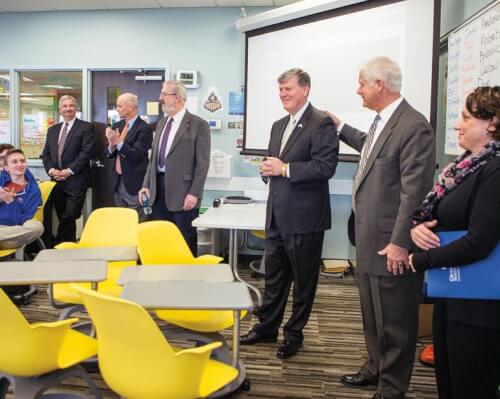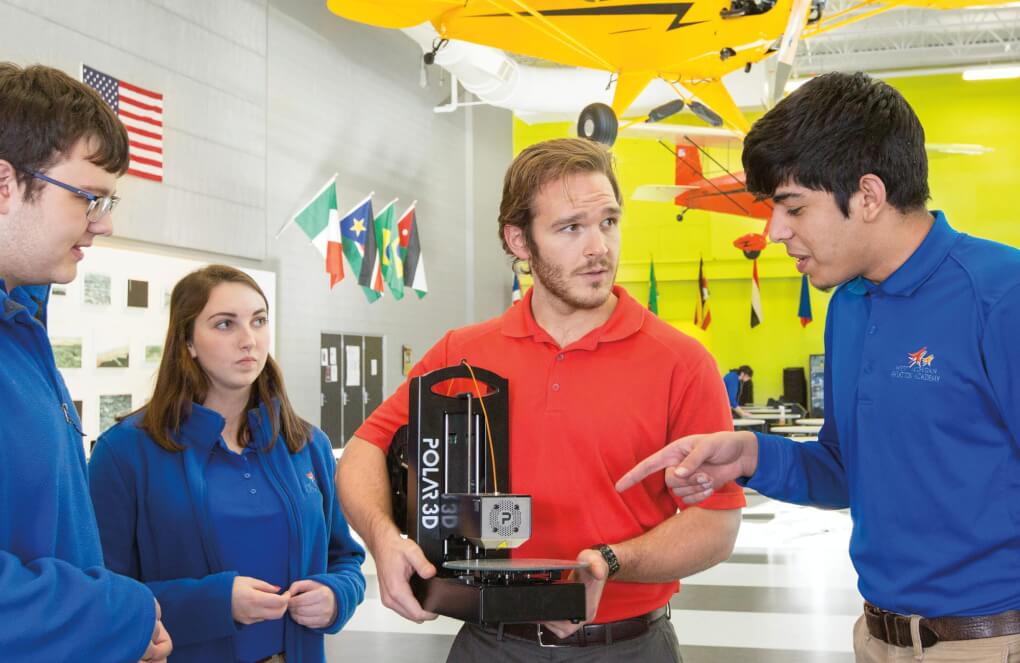Aaron Jonckheere, an 11th-grade student attending West Michigan Aviation Academy, wants to be a mechanical or aerospace engineer. Although he hasn’t decided which one to pursue yet, he wants it to involve his favorite subject: physics.
"I love engineering because it's a practical use of mathematics and science, and you get to solve real problems," said Jonckheere, from Grand Rapids.
Students attending WMAA, like Jonckheere, aren't only learning how to become pilots — they're learning how to make planes and other engineering feats thanks to a strong curriculum, which, in part, is supported by Grand Valley.
A partnership between Grand Valley and WMAA, a charter school on the grounds of the Gerald R. Ford International Airport in Grand Rapids, supports students learning STEM disciplines, and focuses on helping teachers develop curriculum and extra-curricular activities, like FIRST Robotics. As part of the collaboration, a Grand Valley graduate student assists teachers and students, and the university donated equipment to help establish the school’s first fabrication lab.

The idea for a partnership began with Michelle Lindale, assistant dean in the Padnos College of Engineering and Computing, when her son was accepted to WMAA two years ago.
She invited students and teachers from WMAA to visit Grand Valley and, as they say, the rest is history.
At the partnership signing event in February 2016, President Thomas J. Haas said it's important that the university invests in students before they start college.
"We live in a community that values innovation and entrepreneurship, so it’s only natural for Grand Valley and West Michigan Aviation Academy to work together to prepare students as they create, design and build," he said.

Introducing Biomedical Engineering
WMAA faculty member Peter VandenBerg, head of the engineering department, said the partnership is mutually beneficial.
"We've been able to expose our students to different topics and opportunities that we couldn’t purely on our own," he said. "We asked Grand Valley professors to look at our engineering curriculum and determine areas of weakness. They spent a lot of time reviewing it, helping us make decisions and refine our curriculum. That process really solidified our partnership."
Last summer, WMAA faculty member Stephanie Monroe developed a new course on biomedical engineering that was introduced to students this fall. Samhita Rhodes, assistant director of the School of Engineering and chair of biomedical engineering, helped Monroe by providing guidance and direction.
Monroe expected about 20 students to sign up; she was surprised when 57 students enrolled, including 12th-graders Ashley Bogardus and Avery Balaskovitz. The students and their classmates were asked to design custom shoes for people with arch pain for one group project.

“I’m learning so much,” said Balaskovitz, from Coopersville. “This class has not only taught me about biomedical engineering, but I’ve learned about the design process, business models and how to start a company. The material and homework can be hefty, but I really enjoy it.”
Bogardus, from Newaygo, signed up for Monroe’s class because she wants to be a pediatric oncology surgeon. She said the class helped her gain a better understanding of how biomedical engineering fits into the medical industry.
“It’s been really awesome to be a part of a class that no other schools offer,” she said. “I’ve learned how to take a biomedical engineering problem and design something that is tailored to someone’s specific need.”
Monroe is now offering two sections of her class. She said Rhodes’ insight and experience were invaluable. “I would not have gone in the direction I did without her assistance,” she said.
Monroe incorporates design thinking into her curriculum and several Grand Valley student-entrepreneurs have visited WMAA to give presentations.
“Engineering is driven by the discovery of a solution to a problem. Design thinking simply extends that idea to consider how a design might affect a person’s quality of life as well,” Monroe said. “Our students are experiencing so many unique things that come from our partnership with Grand Valley, which not only affords them a more innovative learning experience, but also lends to a growing excitement by some to go there some day.”


Flight of the imagination
The GVSU-WMAA partnership includes the support of a graduate assistant, who spends about 20 hours a week at WMAA. For two years, Kyle Dinger has filled this role as a For Inspiration and Recognition of Science and Technology (FIRST) Robotics coach, and as a teacher.
“I’ve really enjoyed being able to help students come up with new ideas and projects, as well as push them and give them the support they need to make progress,” he said.
VandenBerg said Dinger provides a very diverse set of skills. “In a lot of ways, Kyle has almost become another faculty member here, with the advantage that he has an engineering specific degree,” he said.
Dinger, from Grand Blanc, is completing his last year as a graduate student in the mechanical engineering master’s program. Last year, he assisted a teacher with an advanced robotics class. Halfway through the class, he took over as teacher.
Dinger plans to pursue a doctoral degree. He said when he began looking at programs, he thought he wanted to teach, purely because of his experience at WMAA. While he’s still deciding what to do, he said being a teacher is still on the table.
“I learned that in order to really understand something, you have to teach it,” Dinger said. “The experience was humbling, and the students are so driven and want to learn. It has been a pleasure to be able to interact with them and give them the support they need.”







